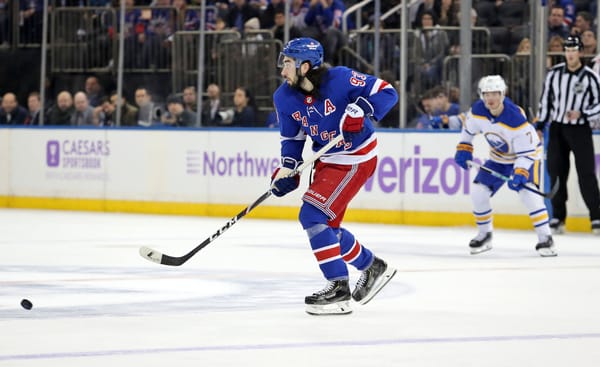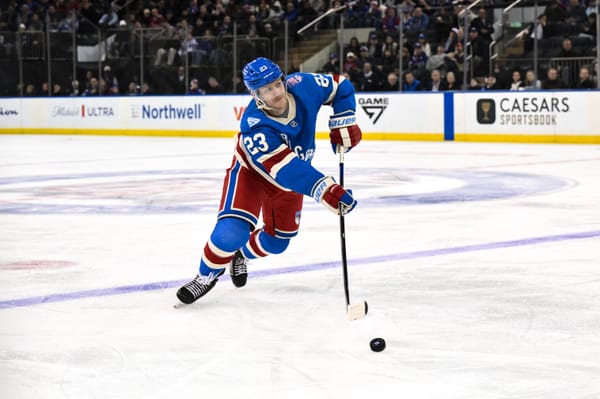In Defense of Derek Stepan
After the New York Rangers elimination in the 2017 Stanley Cup Playoffs, it was suggested by the team, media, and fans, that their core group may need to change. The decision to buyout Dan Girardi was the first indication that the Rangers’ front office acknowledged that their core must change to maintain their status as Stanley Cup contenders. However, there are rumors that this may not be the only change to their core in this offseason – as Bob McKenzie reported, the Rangers are exploring a trade involving Derek Stepan.
Stepan was drafted 51st overall in 2008 by the Rangers and joined the team for the 2010-11 season. In his NHL debut, Stepan made a lasting impression by scoring a hat trick. While that hat trick was not the most indicative measure of the player that he would become, since he is a two-way player, he has nonetheless been a key part of the team in his seven season career in New York.
In 515 career regular season games, he has accumulated 360 points (128 goals, 232 assists). Additionally, in 97 career playoff games, he’s recorded 49 points (19 goals, 30 assists) – many of which have been timely, clutch plays that have helped propel the Rangers deeper into the postseason.
Even after consistently scoring over 40 points throughout his NHL career, Stepan is still a target for criticism. Much of this stems from the fact that he is considered the Rangers number one center, despite not scoring an exorbitant number of points, and that his cap hit is $6.5 million a season.
Last season, after scoring 53 points in 72 games, Stepan’s name was featured in a number of trade rumors. Much of these rumors were because the Rangers had over $11 million in cap space dedicated to their top two centers. Rather than having a clear number one and two center, they had a “1A” and “1B” in Stepan and Derick Brassard. Ultimately, it was Brassard who was traded to the Ottawa Senators in exchange for Mika Zibanejad – who as it stands, fulfills the role as the second line center for the Rangers.
Being a first line center entails facing the most challenging matchups. Now as the clear first line center, Stepan not only competes with those matchups, but maintains his two-way game and consistently scores close to 50 points each season in these situations – making him so valuable to the Blueshirts. Adding to his value is his versatility: his ability to play in all situations. But those points, especially when considering his style of play, are often overlooked and his defensive contributions frequently go unacknowledged – which is why the idea that Stepan does not tangibly contribute enough is unfounded.
Twenty-six year-old Stepan’s play is actually comparable to other two-way centers in the league – like Anze Kopitar (29-years-old, $10 million cap hit), Jonathan Toews (29-years-old, $10.5 million cap hit), and Patrice Bergeron (31-years-old, 6.875 million cap hit).
Stepan, the youngest of these two-way centers, may have slightly lower point totals but is still comparable nonetheless. The most notable difference between Stepan and those centers is that he has yet to win a Stanley Cup. Had he won a Stanley Cup in New York prior to his last extension, his cap hit would likely be inflated like Toews and Kopitar’s. Instead, the Rangers invested in Stepan, in a contract that should continue to prove to be cost-effective as his career progresses.
This season, Stepan scored 55 points (17 goals, 38 assists) in 81 games. At 5v5, he scored 1.69 points per 60 minutes and 1.25 primary points per 60 minutes. Where Stepan contributed the most point-wise was his primary assists. At 5-on-5, he had 14 primary assists that equated to a 0.76 primary assists per 60 – which was second on the team to Mat Zuccarello’s 0.88. Additionally, Stepan contributed to his team with 40 5v5 takeaways, which ranked fourth on the team behind Vesey, Hayes, and Zuccarello.
Stepan’s ability to create shot attempts and limit those against can be demonstrated by his Corsi for percentage of 50.75 – ranking third on offense (behind Zuccarello and Kreider). With Stepan on the ice, the Rangers also were able to generate scoring chances for and suppress those against, as evidenced by his 53.56 scoring chances for percentage (which was the fourth highest on offense, trailing only Zibanejad, Zuccarello, and Kreider).
Also, Stepan’s expected goals for and against were both impressive (53.42 expected goals for percentage, the third highest on offense behind only Zuccarello and Kreider). Stepan’s goals for percentage (59.49) was the highest of the forwards as well, exemplifying how he was on the ice for the best ratio of goals for to goals against.
One of Stepan’s greatest assets is his defensive play, along with his all-around offensive abilities. That two-way play is what has made Stepan such a key player throughout his time with the Rangers, which is why the idea that he is expendable (when considering his skills and contract) is mistaken.
After Oscar Lindberg, the Rangers’ fourth line center, thrived in the playoffs, some believed he could take over Stepan’s role – as a younger, less expensive option. However, the role, matchups, zone starts, and expectations of a first line center and fourth line center are distinctly different. This misconception also fails to recognize the fact that Lindberg is only one year younger than Stepan. As talented as Lindberg is and as critical as his play was in the postseason in particular, he is less accomplished and has yet to prove he can maintain a top-six role and excel in it. Pair that with the fact that Lindberg has yet to establish himself as a leader, in the way that Stepan has to this group.
Until there is a viable trade that includes Stepan, diminishing his role and believing he is so easily replaceable is short-sighted and overlooks just how crucial he has been to this team for the last seven seasons. If the Rangers are going to dismantle the core even more by moving Stepan, then the return must be worth it and genuinely improve the Rangers status as Stanley Cup contenders.
*All data is at 5v5, via Corsica.hockey.




